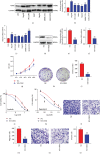Cyclin-Dependent Kinase Regulatory Subunit 2 Indicated Poor Prognosis and Facilitated Aggressive Phenotype of Hepatocellular Carcinoma
- PMID: 31781310
- PMCID: PMC6855053
- DOI: 10.1155/2019/8964015
Cyclin-Dependent Kinase Regulatory Subunit 2 Indicated Poor Prognosis and Facilitated Aggressive Phenotype of Hepatocellular Carcinoma
Abstract
Cyclin-dependent kinase regulatory subunit 2 (CKS2) is a member of the cell cycle-dependent protein kinase subunit family, which is implicated as an oncogene in various malignancies. However, the clinical significance, oncogenic functions, and related mechanisms of CKS2 in hepatocellular carcinoma (HCC) remain largely unclear. In the present study, expression features and prognostic value of CKS2 were evaluated in the bioinformatic databases and HCC tissues. The effects of CKS2 on the malignant phenotypes of HCC cells were explored in vitro. According to the analyses of three bioinformatic databases, mRNA levels of CKS2 were elevated in HCC tissues compared with the normal tissues. Immunohistochemical assays found that high CKS2 expression was closely associated with liver cirrhosis (P = 0.019), poor differentiation (P = 0.02), portal vein invasion (P < 0.001), TNM stage (P = 0.019), tumor metastasis (P = 0.008), and recurrence (P = 0.003). The multivariate regression analyses suggested that CKS2 was an independent prognostic factor for overall survival (HR = 2.088, P = 0.014) and disease-free survival (HR = 2.511, P = 0.002) of HCC patients. Moreover, the bioinformatic analyses indicated that CKS2 might be associated with the malignant phenotypes in HCC progression. In addition, in vitro assays showed that CKS2 expression was higher in HCC cell lines than in normal liver cells. Knockdown of CKS2 remarkably repressed the proliferation, colony formation (P = 0.0003), chemoresistance, migration (P = 0.0047), and invasion (P = 0.0012) of HCC cells. Taken together, overexpression of CKS2 was significantly correlated with poor prognosis of HCC patients and the malignant phenotypes of HCC cells, suggesting that it was a novel prognostic biomarker and potential target of HCC.
Copyright © 2019 Jie Zhang et al.
Conflict of interest statement
The authors declared no conflicts of interest.
Figures





Similar articles
-
Clinical significance and expression of cyclin kinase subunits 1 and 2 in hepatocellular carcinoma.Liver Int. 2010 Jan;30(1):119-25. doi: 10.1111/j.1478-3231.2009.02106.x. Epub 2009 Oct 21. Liver Int. 2010. PMID: 19845855
-
EGFL7 promotes hepatocellular carcinoma cell proliferation and inhibits cell apoptosis through increasing CKS2 expression by activating Wnt/β-catenin signaling.J Cell Biochem. 2018 Dec;119(12):10327-10337. doi: 10.1002/jcb.27375. Epub 2018 Aug 20. J Cell Biochem. 2018. PMID: 30129142
-
CKS2 promotes tumor progression and metastasis and is an independent predictor of poor prognosis in epithelial ovarian cancer.Eur Rev Med Pharmacol Sci. 2019 Apr;23(8):3225-3234. doi: 10.26355/eurrev_201904_17681. Eur Rev Med Pharmacol Sci. 2019. PMID: 31081074
-
Loss of alanine-glyoxylate and serine-pyruvate aminotransferase expression accelerated the progression of hepatocellular carcinoma and predicted poor prognosis.J Transl Med. 2019 Nov 26;17(1):390. doi: 10.1186/s12967-019-02138-5. J Transl Med. 2019. PMID: 31771612 Free PMC article.
-
Systematic summarization of the expression profiles and prognostic roles of the dishevelled gene family in hepatocellular carcinoma.Mol Genet Genomic Med. 2020 Sep;8(9):e1384. doi: 10.1002/mgg3.1384. Epub 2020 Jun 26. Mol Genet Genomic Med. 2020. PMID: 32588988 Free PMC article.
Cited by
-
CKS2 Silencing Affects Proliferation and Apoptosis in Multiple Myeloma through the PTEN/ AKT/mTOR Pathway.J Cancer. 2025 Mar 3;16(6):1987-2000. doi: 10.7150/jca.106190. eCollection 2025. J Cancer. 2025. PMID: 40092696 Free PMC article.
-
Global trends and hotspots in Cyclin-dependent Kinase Subunit 2 research from 1999 to 2022: A bibliometric and visualized analysis.Medicine (Baltimore). 2023 Dec 1;102(48):e36319. doi: 10.1097/MD.0000000000036319. Medicine (Baltimore). 2023. PMID: 38050288 Free PMC article.
-
Expression Profile and Molecular Basis of Cyclin-Dependent Kinases Regulatory Subunit 2 in Endometrial Carcinoma Detected by Diversified Methods.Pathol Oncol Res. 2022 May 27;28:1610307. doi: 10.3389/pore.2022.1610307. eCollection 2022. Pathol Oncol Res. 2022. PMID: 35693634 Free PMC article.
-
Identification and validation of LDHA and SLC16A1 for predicting prognosis and diagnosis in lower-grade glioma.Discov Oncol. 2025 Aug 9;16(1):1511. doi: 10.1007/s12672-025-03297-2. Discov Oncol. 2025. PMID: 40782248 Free PMC article.
-
CKS2 (CDC28 protein kinase regulatory subunit 2) is a prognostic biomarker in lower grade glioma: a study based on bioinformatic analysis and immunohistochemistry.Bioengineered. 2021 Dec;12(1):5996-6009. doi: 10.1080/21655979.2021.1972197. Bioengineered. 2021. PMID: 34494924 Free PMC article.
References
MeSH terms
Substances
LinkOut - more resources
Full Text Sources
Medical

